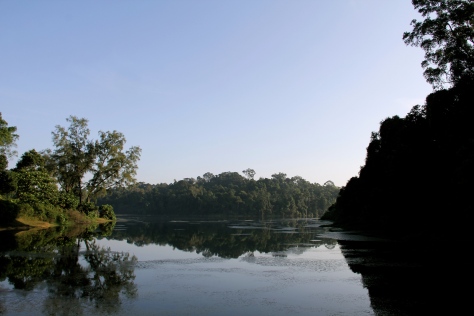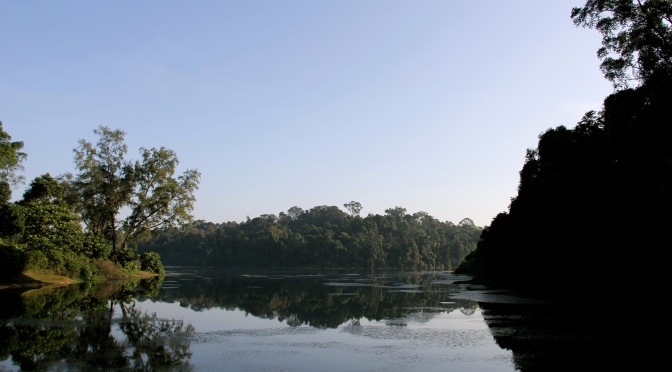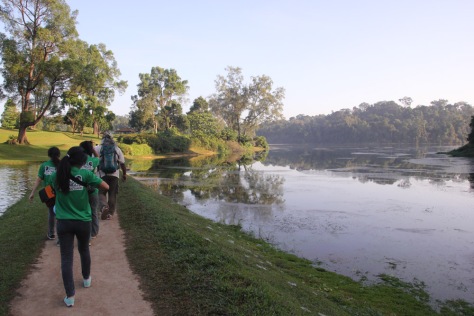Hey everyone! World Water Day is today, and we’ve come up with this special post to share how forests, such as the Central Catchment Nature Reserve, and water, such as our Macritchie Reservoir, go hand in hand to ensure a thriving ecosystem!
First, a brief history lesson. The BES Drongos lead nature walks around the oldest reservoir in Singapore, standing at 147 years. First completed in 1868, Macritchie Reservoir was named after James Macritchie, an engineer that looked to expand it to accommodate an increasing population. When the impounding reservoir was built, the plantations around it were closed down and the forest was allowed to naturally recover from the agricultural deforestation that had been taking place. This dense thick vegetation served a purpose: it protected the reservoir as a precious water resource! Things have changed now. Since the nature reserve and Macritchie Reservoir were opened to the public, it has become a recreational hub for joggers and secondary water sports enthusiasts. But, people are not the only ones who benefit from the water; flora and fauna residing in the area also rely on the reservoir’s water. This is not just only for hydration, but as a living habitat for some species as well, such as turtles.
Water quality in our reservoirs is important to monitor, not just for human consumption, but also as an indicator of how healthy our ecosystem is. Interestingly, dragonflies are known to be indicators of good water quality because they thrive in such areas.
 The presence of forests around the reservoir aid in maintaining this high quality. Leaf litter all around the forest is able to trap potential water pollutants like rubbish such that it does not reach even close to the reservoir. Also, bacteria in wet forest soils carry out denitrification, which is the process of converting nitrates into nitrogen gas to be released into the air. This prevents nitrates, a form of nutrient, from entering the reservoir and causing algal blooms which are capable of killing aquatic wildlife.
The presence of forests around the reservoir aid in maintaining this high quality. Leaf litter all around the forest is able to trap potential water pollutants like rubbish such that it does not reach even close to the reservoir. Also, bacteria in wet forest soils carry out denitrification, which is the process of converting nitrates into nitrogen gas to be released into the air. This prevents nitrates, a form of nutrient, from entering the reservoir and causing algal blooms which are capable of killing aquatic wildlife.
Additionally, forests improve infiltration and stabilize slopes with presence of plant roots, which reduces erosion of soil into the reservoir. The roots of trees create gaps in the soil so that when it rains, water can sink into the soil before subsequently being absorbed by the roots. These root systems of trees and other plants also keep soils porous. Water is filtered through various layers of soil before entering ground water and this process thus allows for toxins, nutrients, sediment, and other substances to be filtered of the water, and kept from entering the reservoir body as well. Without forests, soil is more prone to erosion, so sediment would make the water body murky and also affect the visibility of animals in the water.
 These characteristics of the nature reserve are also re-created with deliberate greenery design in MacRitchie Reservoir Park as part of PUB’s Active, Beautiful and Clean Waters programme. One example is the submerged boardwalk, where plants on the reed beds similarly serve to absorb pollutants, removing these harmful substances from the water supply before it even reaches the reservoir’s filtration system.
These characteristics of the nature reserve are also re-created with deliberate greenery design in MacRitchie Reservoir Park as part of PUB’s Active, Beautiful and Clean Waters programme. One example is the submerged boardwalk, where plants on the reed beds similarly serve to absorb pollutants, removing these harmful substances from the water supply before it even reaches the reservoir’s filtration system.

With several countries experiencing issues of water scarcity and water pollution, clean water sources are without doubt important not just for our daily lives, but also for the survival of species in green spaces around us. In Singapore, the presence of the MacRitchie Nature Reserve and other forests help tremendously in keeping water in our many reservoirs clean. Thus, should we continue to cherish both the water we drink and our environment we live in, Singapore will indeed have many more prosperous years to go.
Words by: Chow Tak Wei




